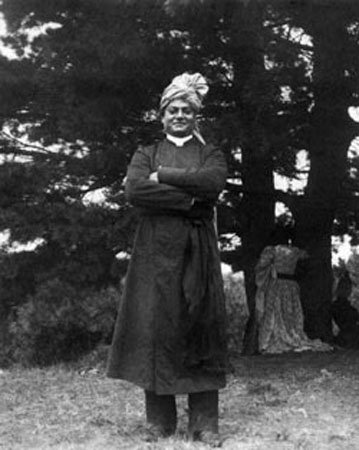Swami Vivekananda
Contributed by Amrita M. Salm, Ph.D. and Prem Reid
Swami Vivekananda Greenacre, Maine in August, 1894
Swami Vivekananda (1863-1902), born Narendranath Datta in Calcutta, was the chief disciple of Sri Ramakrishna. Having traveled throughout India after the death of his teacher, he went to America in 1893, at the age of 28, to represent Hinduism at the World’s Parliament of Religions in Chicago. He became an overnight sensation with his brilliant addresses, his oriental looks, his large eyes, and his grasp of the English language. Swami Vivekananda is credited with introducing the Indian philosophies of yoga and Vedanta to the West and helped advance interfaith dialogue.
After the untimely death of his father, Narendranath struggled with religious doubts, poverty, and hunger. He simultaneously attempted to balance his search for truth and his strong desire to experience the ultimate reality while providing for his widowed mother and siblings. Ultimately, under the care and guidance of Sri Ramakrishna, he would become a lover of humanity.
Swami Vivekananda wrote his brother monks, “Whenever you think of yourself, you are bound to feel restless…. It is only by doing good to others that one attains to one’s own good, and it is by leading others to bhakti and mukti that one attains them oneself. Take that up, forget your own self for it, be mad with the idea. As Sri Ramakrishna used to love you, as I love you, come, love the world like that. Bring all together.” (Complete Works of Swami Vivekananda, 6. 266.)
Not only did Vivekananda enlighten the Western audiences in America and England, but when he returned to India in 1897, he helped his country to understand and work selflessly to raise the masses and women. His ideas sparked an enslaved nation to care for others and forget themselves. He told his countrymen, “Even the least work done for others awakens the power within; even thinking the least good of others gradually instills into the heart the strength of a lion.”
While in the West, Vivekananda started several Vedanta Societies. After he returned to India, the Ramakrishna Mission was started with a focus on serving God in man through hospitals, schools, dispensaries, and village and relief work. Sri Sarada Math, the sister organization for female monastics, was established in 1954.
Swami Vivekananda died at the young age of thirty-nine. He left behind the Ramakrishna Math and Mission, works on the four classic yogas: Jnana Yoga, Bhakti Yoga, Raja Yoga, and Karma Yoga, and what later became nine volumes of his talks, letters, poems and inspiration for future generations to assimilate and absorb in order to become free from their ego and attachments.
Suggested Readings
Vivekananda, Swami. What is Religion? Kolkata: Advaita Ashrama
Vivekananda, Swami. Jnana Yoga, Bhakti Yoga, Raja Yoga and Karma Yoga. (sold separately) Kolkata: Advaita Ashrama.
The Short Life of Swami Vivekananda. Kolkata: Advaita Ashrama, 1995.
Living At The Source: Yoga Teachings of Vivekananda, Edited by Ann Myren & Dorothy Madison. Boston, MA: Shambala Publications, 1993.
The Letters of Swami Vivekananda, Kolkata: Advaita Ashrama, 1970.
The Complete Works of Swami Vivekananda, Vol.1-9. Kolkata: Advaita Ashrama, 2009. Rolland, Romain, The Life of Vivekananda, translatedby E.F. Malcolm-Smith.Kolkata: Advaita Ashrama, 1953.



